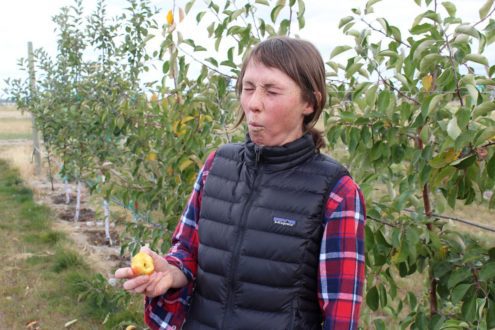

Jul 2, 2019Montana State University studies cider apple production
Katrina Mendrey is the orchard program manager with Montana State University’s Western Agricultural Research Center. She recently answered some questions from Fruit Growers News about her work and insight into cider and antique apples:
Fruit Growers News: Can you tell me a little bit about your position at the University of Montana and your role there?
Katrina Mendrey: I do everything from manage our on-site research trials to assist growers across the state with management topics from establishing orchard to managing pests and fertility. Our current research focus is on cider apple production.
FGN: Are growers in your area interested in antique apples?
KM: We have several heritage orchards that still have living trees folks care very much about. These orchards exist across the state but several of them are located in the Bitterroot, Flathead and Clarks Fork Valleys where apples and other tree fruits have been grown commercially for over 100 years.
FGN: Most of the growers I’ve talked to about heritage or antique apples have had a fair bit of trouble growing them. What have you learned about growing heritage apples, and what tips or techniques can you pass onto other growers?
KM: The heritage apples we grow at the station for our cider trials have a lot of issues with fire blight so we manage them very carefully when they are young. This is different though from the heritage apples we are interested in that are already growing and have been for over 100 years in Montana. Our interest in these apples is that they should by nature be easy to grow as they have withstood Montana’s harsh climate with little to no management for decades. I think the answer changes in how you define heritage apples.
FGN: Can you tell me a little bit about Idaho/Montana as apple-growing regions. Are the soil, sun, water conducive to apple growing?
KM: Montana is great for growing certain cultivars in areas where irrigation can be used. Some of our favorites are Honeycrisp, MacIntosh, Gingergold, Sweet Sixteen, Zestar!, Gala, Haralson and Wealthy. We have nice warm days and cool nights which result in a crisp and flavorful apple. As long as the apple can ripen during our short growing season we can grow it.
FGN: What are some of the pests and weeds you have to deal with in your location there?
KM: Weeds are a major problem especially perennial weeds like quack grass, thistle and bindweed, but they can be controlled with proper management. Our primary insect pest is codling moth and the disease is fireblight, we have some scab but it all can be managed and I think this is one of the reasons Montana is such a great place to grow apples – our disease pressure is relatively low.
Above, Katrina Mendrey tastes a bitter apple. Photo: Michelle McConnaha/Ravalli Republic
‘Lost,’ antique apples of the West examined for cider potential














